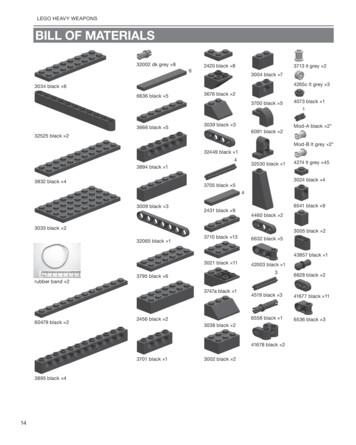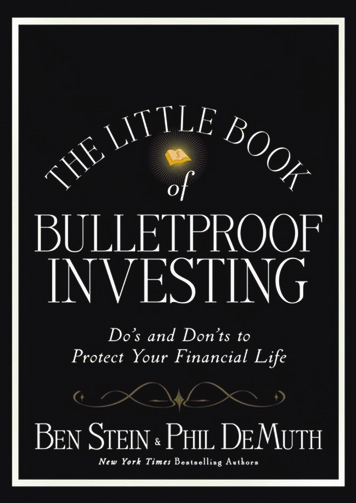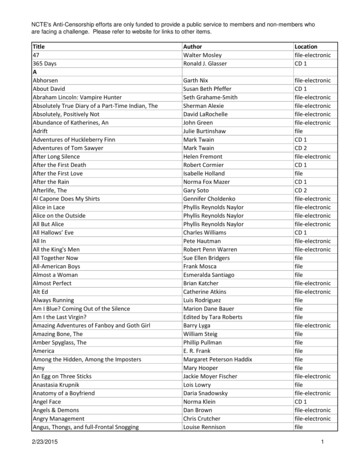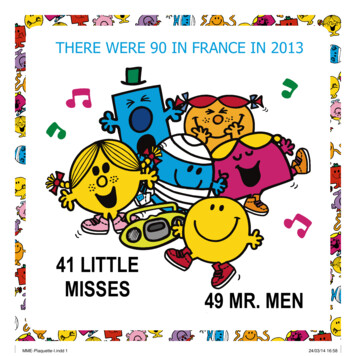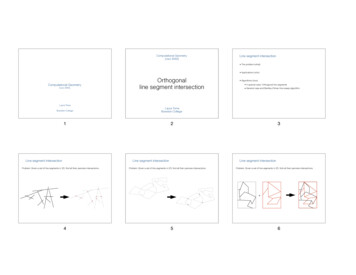
Transcription
My Little Black BookofTrainer SecretsType to enter textHow to Train AnyAudience on Any Topiccopyright 2012 Corporate Trainer
Dear Friend and Colleague,This special report is going to show you how you can influence any group orprospective client and engage them to listen, interact, and build rapport with you assomeone they can trust and pay for your services again and again.The ease of getting a training qualification as well as the explosion of informationproducts and out there has meant all freelance and contract trainers have to workextra hard to get noticed, to get work and to make a difference.You probably got into this line of work because you were good at your job, or you saw itas a way to make a difference to organisations. Maybe you wanted the lifestyle toptrainers get working 6 months of the year on a 6-figure salary.But being good at your job sometimes doesn’t transfer to the people in yourtraining room, and/or the organisation just doesn’t get it and the change doesn’tstick. Or maybe you find the work comes in either feast or famine fashion - and trainingany audience on any topic will do as long as it’s work, right?But there is more to it, and, as you read on, you’ll discover what top trainers doto stand out from the crowd.And if you become a top-tier trainer you get access to amazing opportunities to workwith innovative companies, inspired leaders, and creative people all around the world.Now that’s living the Adventures of a Corporate Trainer.To your SuccessPeter A. SmithWork Smart. Do Good. Live Great.copyright 2012 Corporate Trainer
6 Awesome Ways to Impress Potential Clients, Energise & Engagewith Participants & Build Your Training Business.The Truth Shall Set You Free Let’s face it; we are only as good as our last gig. Training budgets are shrinking, that old flipchart or power point circa 1998 won’t cut it anymore, and ‘entertrainment’ just isn’t sustainablein a world that wants authenticity.Sharing trade secrets like I do on my site means saying it like it is. Training and facilitationand coaching is part art, part science, it’s no bullshit. And we have to constantly work at it.Every. Single. Time. We. Work.It’s a craft and it demands integrity in our actions. Your character shows up in every interactionand that is what clients are buying from you. That means what you say, and how you say it haseverything to do with your bottom lineChangeDevelopTransformAre you a Top-Tier Trainer, or are you scraping thebarrel for more work?If you’re like a lot of trainers out there, you get by, take the work you can, and make a decentliving. As I said before though; you’re only as good as your last gig.I want to ask if you’ve experienced any of these things.Have you ever felt out of your depth in a training room, like you didn’t know what to donext?Have you ever run out of training material before you’ve run out of time?Perhaps your training has started and five minutes in you realise what you had plannedisn’t going to fly with the crowd of people before you.copyright 2012 Corporate Trainer
Have you ever been put on the spot to come up with some material, or had a client askto see you ‘think on your feet’.Or worse, have you ever stood in front of a group and got a feeling they don’t know whythey are there.When this has happened to me my heart seems to push out with each beat and a little bead ofsweat slowly forms, then rolls down my lower back?When it happens it dints my confidence, loses me credibility and its taken years to get better atdealing with.If you can relate to some, or all, of these things, I have good news for you. In this report, and allthe other training resources on the site, you’re going to discover how to overcome all thesechallenges.That’s why I created The Adventures of a Corporate Trainer. This is for you. I would have loveda site like this when I was starting out.Work Smart. Do Good. Live Great.Now, my clients know they can put me in front ofanyone – from C suite executives in accountingfirms in the city to frontline staff in factories in thesuburbsYour clients need to know they can put you infront of any audience and deal with anythingthat comes up.Whether you are a contract trainer, an associate, or in an L&D role training -flexibility, andthinking on your feet, is a pretty important skill to have.There are too many trainers out there who have received minimal education in how to conductadult education and are up against you for key jobs. You could be losing work to someone whohas way less skill or experience than you.Worse still, your income can suffer if you are not able to improvise and work with whatcomes up in the room because you will not get invited back if you can’t handle diversity andbe flexible.copyright 2012 Corporate Trainer
So in this report you will learn how to become indispensable, engaging, flexible, reliable,and get hired again and again. There are a few tricks to getting good at this.1. What it means to be a training consultant.612. Thinking on your feetKey Factors to3. The Four-Step Questioning Processimprove theadventure in4. Naming the Elephant in the Roomyour trainingbusiness5. Story Telling6. Transfer of TrainingPutting on the Consultant’s HatMany years ago when I first started in this industry, I’ll never forget the feeling ofgoing in to one of the big banks for a presentation interview. I was asked tofacilitate a 30-minute session of my choosing to a group of 5 or 6 members ofthe learning and development team as a way for them to evaluate my skills as atrainer.I was shitting myself, to be honest. It was a great role, responsible for a national culture changeprogram across the whole company, with a big fat salary to boot.5 minutes in and I floundered. One woman, the thought leader behindthe program, was sitting in the corner of the large mahogany conferencetable and didn’t respond to my questions, or even look up as I began mypresentation.It unnerved me. Actually, it pissed me off. How dare she keep readingmaterial unrelated to my presentation and taking notes, as though shewas just sitting there because they ran out of desk space down in theoffice.copyright 2012 Corporate Trainer
As you could imagine, feeling the way I did, thewhole session didn’t go so well. I didn’t get thejob.I later reflected on why I lost it. I realized myunwillingness to put on my consultants hatand deal with not only my own feelings, butalso the reality of what this person was doingin MY session.I was there to perform, not be derailed bysome ring-in who didn’t give rip about mysession. Sound familiar.As you’ve probably already gauged, that woman was playing the perfect role to see how Iwould react.Emotional Intelligence is the cornerstone competency of being and in-demand trainerand in this experience, I sucked at it.I took the bait; hook, line and sinker.Do you ever find yourself in situations where you have a hunch about what should be done orsaid but don’t follow it. This was one of those times.That’s what this report is about essentially; making sure you don’t leave out gaps in yourpresentation that can be filled by other agendas or ulterior motives.Flush them out. NicelyThe word consultant is derived froma Latin word consultare, whichmeans, "to discuss". It is importantto open discussions with as manylevels of an organisation as youcan prior to a training agreement.copyright 2012 Corporate Trainer
When you gain access to the right levels ofmanagement here are some great questions thatwill confirm your role as a consultant; someonewho adds value and is results driven. What problem are they trying to solve? What change/s are they trying to make? What are they trying to do differently, orbetter?Obviously, there are many different questions andways of asking them and these should help you get off to a great start. To dig deeper on thesequestions you can also ask: What are the expectations you have of this training intervention? And what are your concerns? What led you to this training at this time? Why this group of people? What support options are in place following the training?Sometimes getting to the root-cause of an organisation’stroubles can be scary. The issues can often be big andcomplicated. Start by breaking down the priorities of theorganisation and build those pieces into your trainingprogram.Remember, that as a training consultant you should alwaysbe mindful of the greater priorities of the organisation andholding that vision will make all of your programcommunication more congruent; you’ll be talking theirlanguage.Putting on the consultants’ hat will ensure that you don’thave to do too many back bends to training any audience on any topic.Let’s see how I learned my lesson from that presentation at the bank to nail a gig with a newclient, many years later.copyright 2012 Corporate Trainer
2Thinking on Your Feet“Are you crazy”.This is not the sort of response you’d expect from the director of a large trainingcompany.“What on earth are you going to talk about”.I’d left the corporate world, a national role in learning and quality assurance, and packed thecar to go north to Sydney. I spent nearly three months on the phone ringing trainingcompanies offering my services.Every day I was scouring the yellow pages, researching web-sites, speaking to people who hadmy financial future in their hands. Some days I wanted to give up and drive back home to ‘realjob’ land.Some days I had a second wind and worked out my pitch perfect. Each time I landed aninterview it invariably meant going in to do a presentation then getting grilled by the businessdevelopment folks.I hadn’t had much luck going in to do prepared presentations; it was a bit surreal, andhonestly, I got too nervous and stuffed it up for the most part.copyright 2012 Corporate Trainer
Scouting for more work as a freelance trainer can betough.So when a potential client - like this director on the phone withme now - asks me to come in and give a presentation to thesales team who will put me in front of their clients - and I don’twant to prepare anything – that doesn’t help either.“Tell me when I get there what you’d like me to present and I’llmake it up on the spot.” I said with quaky confidence in myvoice.It worked. Now, companies hire me to fly around the world and ensure that whatever happensin their training room, as their ‘go-to’ guy, I can handle it.Let me explain how and help you to achieve improvisationand flexibility.Here’s the trick to training any audience on any topic. I’m notfeelingreferring to skills based or technical subjects like ‘excelhow we think about thingsconcrete experience‘Delegation and Motivation for Employees’ or ‘Leading withoutAuthority’The learning process that individuals go through is a sequenceof questions - the learning cycle – and our training sessionshould follow this cycle.These questions also form the preferences, or learning styles, ofthe majority ofpeople.It’s called the 4-MAT, you’ve probably heard of it, and full credit toBernice McCarthy for sharing it with the world.So this is a nifty little tool to have up our sleeve when time runsshort in our training session, or we’ve been put on the spot tocome up with content in a hurry, or you get a group that perhapsdoesn’t want your training. Maybe, like in my story, you just want toimpress a potential client.copyright 2012 Corporate Trainerdoingactiveexperimentationprocessing continuum - how we do thingsprocessing continuumspreadsheets 101’, or ‘Occupational Health and Safety for ForkliftDrivers’ but more conceptual and behavioural type topics likethinkingabstract conceptualisationwatchingreflectiveobservation
WHY3The 4-MAT Questioning ProcessLet’s start with the four questions as a quick review, then, seewhat we can do with it WHAT1.WHY - Do the participants need to know what you are teaching?HOW2.WHAT - Is the information about – the theory?3.HOW - Will the participants learn what you are training?WHATIF4.WHAT IF - Happens when they start to think about how they will apply whatthey’ve learnt?A Road Map for this SectionIn this part of the report I am going to jump around a bit. Let me explain how it’s structured.We’ll start with the ‘Why’ question, which is about how to engage your participants and workwith their resistance to the training and getting buy-in to the training. Because of that I haveincluded the section on ‘Naming the Elephant in the Room’ just the why question.Then I jump into the ‘What’ question, and move to story telling as a way toengage and get people sharing and interacting; ‘what’ is the training about andhow does the ‘story’ about the information they are here to learn get told.Then I finish off with the ‘How’ and ‘What if’ question.So let’s get started with the ‘Why’ question.What do you say when you don’t know what to say in a trainingsession?O.K. so let’s say it’s two thirty in the afternoon and you have hit a blank spot; you don’t know ifthe material you’ve got will get you through the day and interaction levels are falling likeparticipants eyelids.copyright 2012 Corporate Trainer
Start with a ‘Why’ question. This should be aquestion that creates curiosity in the content toWHY?come.Ask any why question. For example, let’s say I am trainingcall centre operators (something for which I am clueless) andthe subject is difficult customers: Why do people in general become difficult to deal with? Why do we react so negatively to them at times? Why does it happen in our industry/with our product in particular?You should get some good interaction going with those questions to start you off.But before I go on to the ‘What’ question is worth pausing at this point to deal with somethingthat inevitably happens in workplace training.4Naming the Elephant in the RoomSee, all too often, we as trainers find ourselves in front of a group that eithershouldn’t be there in the training room, don’t want to be there, have been told tobe there, or have had such a bad run with boring training that we as the trainersare the recipients of that negative vibe.Trainers need to have a strategy to deal with resistant participants because if theydon’t, they get caught out, lose their cool, their credibility and may lose the job. One wayto name the elephant in the room is to call it as you see it.First thing to do is acknowledge what’s going on. Some people may not want to be in yourtraining room. That’s a reality.Your job at the outset is to confront this challenge by acknowledging their position. A great wayto do this is with a flipchart that identifies it all. Reveal the following flipchart titles and explaineach to the group seated before you.Shopper – gets a day or two off work to attend the trainingand is there to browse the program and see what’s worthtaking home.Conscript - has been sent to the training by someone elseand probably doesn’t want to be there.Adventurer - is up for anything and wants to learn.Volunteer – Needs convincing but will go along for the ride.copyright 2012 Corporate Trainer
Once you’ve established who these participants are, they’vegot nowhere else to hide. That means they can’t sabotage yourtraining as easily at they normally could. And by putting theirhand up to this you’ve got license to be transparent with them ifthey do.Then, once you’ve got that out of the way, you can begin to askthe next questions in the 4MAT.WHAT?The answers you get from the ‘Why’ questions candetermine the ‘What’ questions that will get the bestresponse.Let’s get back to our call centre operators and dealing with difficult people. Forexample; If I ask “why do people in general become difficult to deal with”, and the answers yougot back from participants was: ‘They don’t get what they want’, The ‘what’ question you thenask could be “what sort of things do they want from your product or service?”Other examples to find out what they already know could be What has worked to calm you down when you’ve been difficult to deal with? (orsomeone you know has been difficult :) What do you think people really want then they are being difficult? What must we never do when we have a difficult person on the other end of the line?By now your participants will be reflecting on their experiences of dealing with difficult people.They’re sure to have a few horror stories.5Story TellingIf you are really thinking on your feet you can bring in astory or anecdote that relates to the material.It is vital to find a relevant link that will connect thepower of the story, analogy or metaphor to the trainingcontent and the point you want to get across.For instance, in this example, you could think of the lasttime you were annoyed with a call centre operator andwhat did they do that worked to calm you down, or what didn’t work.copyright 2012 Corporate Trainer
Story Telling StructureThe key structure of an effective story involves four elements:Context: The context or environment in which the storyis set. It could be in a workshop, an office, out in thefield; ideally it is a setting the participants can relate to.Characters: the key players in the story and what isgoing on for them – what they might be thinking andfeeling. Don’t be afraid to give them some character;describe their facial features or how they move.Conundrum: The situation, scenario, problem, orchallenge the characters are faced with.Clarity: What did the characters understand or resolveabout the situation that lends itself to the reason youtold the story?You can scour your work history for the best stories and anecdotes. Some trainers readthe business pages to find the most relevant material for a particular client.My earlier story about making up a presentation on the spot to the training director in Sydneyhad all these elements.Context: Finding more work as a trainer after moving to Sydney.Character: The training director and sales people.Conundrum: I needed to stand out amongst so many other trainers canvassing to becontractors.Clarity: How to effectively demonstrate to potential clients my ability to think on my feet.If a picture is worth a thousand words, a story is worth a thousand pictures.Remember, establish curiosity and engagement with the ‘why’question and build theory and content with the ‘what’question.Moving on, the ‘How’ question takes you in a number of directions. If you had timeHOWto prepare you would obviously have some sort of experiential activity to facilitateat this point. But because we could be training any audience on any topic we canonly use what has come up in the session we’ve created on the spot.copyright 2012 Corporate Trainer
We can do one of three things:1. Generate a Case Study:2. Organise a Role-Play:3. Build a Template:If someone has given you aYou could organise a role-Get a blank flip chart andjuicy enough anecdoteplay with the incidentwrite up responses frompreviously, you couldgenerate a case study anddescribed and haveparticipants take it in turnsthe group which help themto build a tool kit or seriesask small groups to offerto deal with it. You couldof steps; e.g, ‘the six secretstheir suggestions on how todeal with it.use a useful discussionmethod like O.R.I.D.to dealing with difficultcustomers’ or ‘four steps tokeep your sanity at work’ orwhatever was the essenceof the discussion youfacilitated.6Transfer the TrainingTranslating the discussion into workplace examplesThe final questioning step is the ‘What If’ question.Following with our example from the call centreWHATIF?operators, you will want to establish what the roadblocks and obstaclesare to effectively dealing with difficult clients. This might generate abigger discussion about company policy or further training needs.And in this example at least you have drawn out some participantlearning from each other, bought yourself some time, and got theinteraction levels back up if they were waning.I am going to let you in on a little secret, you may have already realised ifyou’ve been in the game long enough: It’s all about results. That’s all your clients want; anoutcome that solves their problems.If you refer back to the section on ‘wearing the consultants hat’ you’ll recall the questions. Thisis where you bring them back into the training. You have to constantly return to theobjective of the training as it relates to what the organisation is trying to achieve.copyright 2012 Corporate Trainer
Let me highlight the importance of this with an experience of mine. This means so much foryour business you won’t believe the return – in more work – and in great experiences.I was contracted on a job just outside of Frankfurt. A few months earlier in Dallas, I had trainedthe subject matter experts in the organisation on how to train and facilitate new managers intothe company.It was great to work alongside them now as the groupfacilitator, and it was an important step for the companyto let their new trainers loose.Of course, as part of the quality control measures withthe content, and senior people getting good training,members of the global learning and development teamsat up the back, watching our every move.Not only did my budding trainers nail it under thewatchful eye of their bosses, but because of the impact of my work; ensuring the training I rantransferred to this day – I was invited back for more training.In Mexico city, Johannesburg, Manilla, Beijing, Montreal, London and Sydney.I don’t say that to impress you, but to impress upon you that you can never know where yourgreat work will take you.This is what I do to knock the socks of potential clients at an interview/audition, or to keepgetting great gigs. Try it out a few times to get the hang of it, then trust yourself, you know yourstuff.copyright 2012 Corporate Trainer
trainers get working 6 months of the year on a 6-figure salary. But being good at your job sometimes doesn't transfer to the people in your training room, and/or the organisation just doesn't get it and the change doesn't stick. Or maybe you find the work comes in either feast or famine fashion - and training
